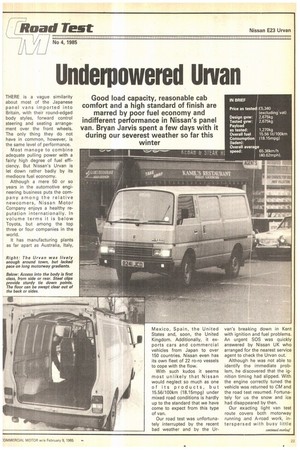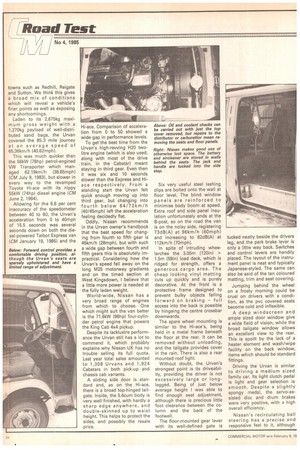Underpowered Urvan
Page 25

Page 26

Page 27

If you've noticed an error in this article please click here to report it so we can fix it.
Good load capacity, reasonable cab comfort and a high standard of finish are marred by poor fuel economy and indifferent performance in Nissan's panel van. Bryan Jarvis spent a few days with it during our severest weather so far this winter
THERE is a vague similarity about most of the Japanese panel vans imported into Britain, with their round-edged body styles, forward control steering and seating arrangement over the front wheels. The only thing they do not have in common, however, is the same level of performance.
Most manage to combine adequate pulling power with a fairly high degree of fuel efficiency. But Nissan's Urvan is let down rather badly by its mediocre fuel economy.
Although a mere 50 or so years in the automotive engineering business puts the company among the relative newcomers, Nissan Motor Company enjoys a healthy reputation internationally. In volume terms it is below Toyota, but among the top three or four companies in the world.
It has manufacturing plants as far apart as Australia, Italy, Mexico, Spain, the United States and, soon, the United Kingdom. Additionally, it exports cars and commercial vehicles from Japan to over 150 countries. Nissan even has its own fleet of 22 ro-ro vessels to cope with the flow.
With such kudos it seems most unlikely that Nissan would neglect so much as one of its products, but 15.56/100km (18.15mpg) under mixed road conditions is hardly up to the standard that we have come to expect from this type of van.
Our road test was unfortunately interrupted by the recent bad weather and by the Ur van's breaking down in Kent with ignition and fuel problems. An urgent SOS was quickly answered by Nissan UK who arranged for the nearest service agent to check the Urvan out.
Although he was not able to identify the immediate problem, he discovered that the ignition timing had slipped. With the engine correctly tuned the vehicle was returned to CM and the road test resumed. Fortunately for us the snow and ice had disappeared by then.
Our exacting light van test route covers both motorway running and A-road work, interspersed with busy little towns such as Redhill, Reigate and Sutton. We think this gives a broad mix of conditions which will reveal a vehicle's finer points as well as exposing any shortcomings.
Laden to its 2,675kg maximum gross weight with a 1,270kg payload of well-distributed sand bags, the Urvan covered the 85.3 mile journey at an average speed of 65.36km/h (40.62mph).
This was much quicker than the 58kW (78hp) petrol-engined VW Transporter which managed 62.19km/11 (38.65mph) (CM July 9, 1983), but slower in every way to the revamped Toyota Hi-ace with its nippy 55kW (74hp) diesel engine (CM June 2, 1984).
Allowing for the 6.6 per cent inaccuracy of the speedometer between 40 to 60, the Urvan's acceleration from 0 to 40mph of 15.5 seconds was several seconds down on both the diesel-powered Talbot Express van (CM January 19, 1985) and the Hi-ace. Comparison of acceleration from 0 to 50 showed a wide gap in performance levels.
To get the best time from the Urvan's high-revving H20 twolitre engine (which is also used, along with most of the drive train, in the Cabstar) meant staying in third gear. Even then it was six and 10 seconds slower than the Express and Hiace respectively. From a standing start the Urvan felt quick enough moving up into third gear, but changing into fourth below 6 4/7 2km/h (40/45mph) left the acceleration feeling decidedly flat.
Oddly, Nissan recommends in the Urvan owner's handbook that the best speed for changing from fourth to fifth gear is 45km/h (28mph), but with such a wide gap between fourth and fifth gears this is absolutely impractical. Considering how the Urvan's speed fell away on the long M25 motorway gradients and on the timed section at West Kingsdown, I believe that a little more power is needed at the fully laden weight.
World-wide, Nissan has a very broad range of engines from which to choose. One which might suit the van better is the 71.6kW (96hp) four-cylinder petrol engine that powers the King Cab 4x4 pickup.
Despite its lacklustre performance the Urvan still has a lot to commend it, which probably explains why Nissan UK has no trouble selling its full quota. Last year total sales amounted to 1,308 Urvans and 1,924 Cabstars in both pick-up and chassis cab variants.
A sliding side door is standard and, as on the Hi-ace, there is a broad top-hinged tailgate. Inside, the 5.6cum body is very well finished, with hardly a sharp edge anywhere, and double-skinned up to waist height. This helps to protect the sides, and possibly the resale price. Six very useful steel lashing clips are bolted onto the wall at floor level. The blind window panels are reinforced to minimise body boom at speed. Extra roof and side panel insulation unfortunately ends at the B-post, so on the road the van is on the noisy side, registering 73dB(A) at 96km/h (60mph) and increasing to 82dB(A) at 112km/h (70mph).
In spite of intruding wheelarches the 3.05m (120in) x 1.5m (59in) load deck, which is ridged for strength, offers a generous cargo area. The cheap looking vinyl matting cuts up quickly and is purely decorative. At the front is a protective frame designed to prevent bulky objects falling forward on braking — full access into the back is possible by hingeing the centre crossbar downwards.
The spare wheel mounting is similar to the Hi-ace's, being held in a metal frame beneath the floor at the rear. It can be removed without unloading, and the tailgate provides cover in the rain. There is also a rear mounted roof light.
Without doubt, the Urvan's strongest point is its driveabil ity, providing the driver is not excessively large or longlegged. Being of just below average height I was able to find enough seat adjustment, although there is precious little foot clearance between the column and the back of the footwell.
The floor-mounted gear lever with its well-defined gate is tucked neatly beside the drivers leg, and the park brake lever is only a little way back. Switches and control levers are handily placed. The layout of the instrument panel is neat and typically Japanese-styled. The same can also be said of the tan coloured matting, trim and seat covering.
Jumping behind the wheel on a frosty morning could be cruel on drivers with a condition, as the pvc covered seats become cold and inflexible.
A deep windscreen and ample sized door window give a wide field of vision, while the broad tailgate window allows an excellent view to the rear. This is spoilt by the lack of a heater element and wash/wipe facility on the back window, items which should be standard fittings.
Driving the Urvan is similar to driving a medium sized family car. Its light clutch pedal is light and gear selection is smooth. Despite a slightly spongy meda:, the servo-assisted disc and drum brakes were very positive, with a high overall efficiency.
Nissan's recirculating ball steering has a precise and responsive feel to it, although
like the Hi-ace it has a fairly wide turning circle of 12.3m (40.4ft) between walls.
Torsion bar suspension at the front is a bit on the soft side, and it did tend to wallow a bit on undulating road surfaces, but in general it handled well, especially around town.
Daily checks on the oil and water can be carried out by lifting the cover from between the two seats. Changing the oil filter has to be carried out from underneath, although with both seats and their bases removed there is adequate space for most major repairs. Servicing the distributor is done this way too.
The Urvan has powerful headlamps with well defined beam spreads. The panel lights have a green translucence that defies glare. However, the manual choke has no warning light. Equally annoying is the lack of illumination for the heater and ventilation controls, so one must fumble around at night.
Summary
First produced 11 years ago the Urvan is now present in various guises around the world. For the UK market its specification has hardly changed, although three years ago it had a number of cosmetic revisions.
The van has numerous strong points, such as the useful 5.6cum carrying capacity with very good access into the rear or from the standard side sliding door.
It is very easy to handle, especially around town, has an attractive style and is competitively priced at £5,340 against, say, the Ford Transit 120 at £5,411 or the 67kW (90hp) VW Transporter at £5,979.
Despite the van's disappointing fuel economy and generally lacklustre performance, Nissan UK seems able to sell all the Urvans and Cabstars that it imports. However, neglecting to improve a product in a highly competitive market like ours is just the situation that the Japanese have themselves exploited in the past. Such neglect could cost them sales.


































































































